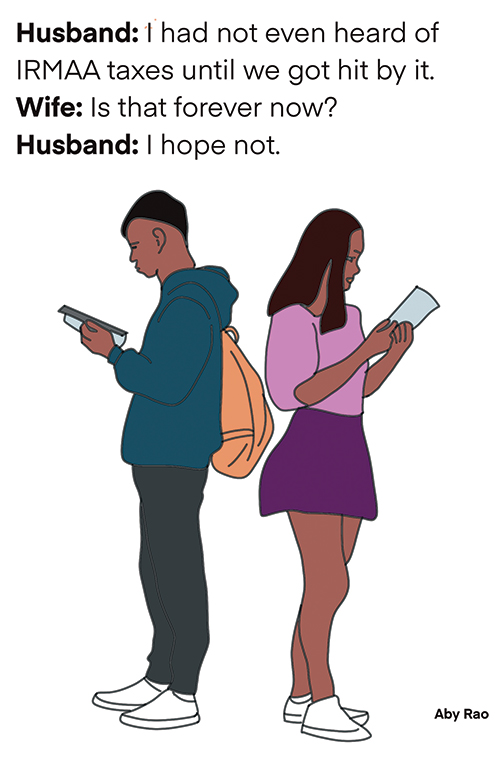By Mo Vidwans

An obvious question that pops up, in my head at least, is why would retirees have a problem or any concern with taxes? Generally, their income will be down compared to when they were working full time. They will be withdrawing and not adding money to their accounts and the expenses will keep going up every year, at the least with current inflation.
Well, all of that is true but there are many retirees who can earn as much, or even more, as they may spend in their retired life and they have the usual coterie of pension (maybe), social security income for sure and RMDs at some age of their life that they have to deal with.
 I get at least one question a month about additional surcharges they are paying on their regular Medicare premiums because their income has gone up. Now this sudden income rise can be temporary, and you may not pay that additional tax (called IRMAA surcharges; explained in the December 2023 article) for more than a year. But the point is perhaps that the IRMAA surcharges could have been avoided too if we had planned our withdrawals well.
I get at least one question a month about additional surcharges they are paying on their regular Medicare premiums because their income has gone up. Now this sudden income rise can be temporary, and you may not pay that additional tax (called IRMAA surcharges; explained in the December 2023 article) for more than a year. But the point is perhaps that the IRMAA surcharges could have been avoided too if we had planned our withdrawals well.
There is a conflicting dilemma all retirees face: on one side they must stretch out their total asset base as much as possible and on the other side they must make sure that they are able to live reasonably well for the rest of their lives. This is a conflicting requirement to say the least.
Obviously, retirees have some variables to consider and deal with. They have their own variety of assets consisting of three items that retirees will struggle with – 1: their own savings accumulated over the years, 2: their own illiquid asset base like house(s), vacation property or properties, cars, special jewelry, 3: the non-taxable assets like 401K and IRAs and other monthly incomes like social security and annuities.
I am not considering here their most important asset, if we can call it that, which is their own health. Health is important but we cannot put value on it because it is fickle and fleeting, to say the least, at the age when people retire.
Before I go any further, let me also point out that there are three definite segments of a person’s age that need to be considered and different decisions need to be made in those age brackets when they get serious, and thoughts of retiring become prominent in their minds.
These age brackets are 1: from 59.5 to 65, 2: from 65 to 73 (75 after year 2033), and 3: 73 (or 75) and up. It will also become clear in your mind that to consider minimizing the impact of taxes you have to consider the entire period from 59.5 to 73.
Why is this entire period important? Pivotal points are 59.5, 65 and 73 (75 after year 2033). After 59.5 you can withdraw from your retirement accounts without paying additional penalty; you still always must pay regular income taxes on all such withdrawals. At 65 Medicare coverage starts and I think most of us know that even if we keep working after that the place where we work will make Medicare as primary health insurer and, if the employer offers its own plan, it will be secondary. Very rarely do I notice an employer not doing this. At 73, we reach a point where we must start withdrawing from our retirement accounts, what is known as RMD (Required Minimum Distributions), and we do not have a choice there.
From the tax point of view, my observation is that at 73 people get very upset because RMD sets in and it forces the income to go up, sometimes substantially, and the end result is not only it could push us into higher tax bracket but sometimes IRMAA kicks in too, adding at least $100 per month additional premium per person. If you are filing married filing jointly (MFJ) then it is a hit of $100 for each.
So let us now look at the three age groups that I mentioned earlier. It will be beneficial to go backwards; hence let me first consider the last bracket of 73+. Because one must withdraw at this age, the retiree is a bit helpless here if nothing is done in earlier brackets to abate the taxes. But there is hope. You have heard of QCD (Qualified Charitable Distribution). You also may have realized at that stage in your life that with no mortgage to make monthly payments on and a 7.5 percent reduction of health expenses before they can be deducted it is difficult to reach the high bar of standard deduction and many taxpayers cannot take advantage of what is available for itemizing deductions.
If that is where you are then you can at least take all the cash donations, which would have been wasted for tax purposes, and claim them as QCD. You must follow certain rules though. These donations must come out of your RMD and be directly paid by the people who manage your retirement account. They also should be paid before you take your RMD and cannot exceed $105,000 per year (for 2024; it is now linked to inflation).
Those who cannot take advantage of itemized deductions find this very useful. It reduces your gross and taxable income by your donations and hence less taxes are due. If done properly it could also bring you under the IRMAA bracket. You can take QCD only when you are over the age of 70.5.
That brings us back to the middle bracket which is 65 to 73. What happens here and more importantly what we do here is intimately tied to what we do in the first bracket which is 59.5 to 65. Here, we are seriously considering starting social security, we may still be working part-time or full-time, more than likely we have switched to Medicare as our Primary health care giver and there is income from our investments of all these years (dividends primarily) or maybe from rental properties.
IRMAA is always lurking in the background and if nothing else the danger of crossing into the next income tax bracket is always there. My wife had suggested once in a moment of exasperation: “there is nothing wrong with any of this; if we have it, just pay a bit more taxes and enjoy it, NO need to lose sleep over it.”
That is certainly one point of view and in my case, it carries a lot of weight. If we are thinking of minimizing our income and hence taxes the answer to that is to consider what needs to be done in the first bracket, mainly from 59.5 to 65.
The goal in this bracket is to reduce the total size of non-taxable assets like IRAs. It has to be done carefully by watching our income tax brackets and making sure that we stay in the same bracket and not inadvertently push ourselves into the next income-tax bracket. We must pay taxes on what we withdraw but by staying in the same bracket. This also suggests slowing down investing in the retirement accounts.
Keep in mind that the tax rate for different brackets does not move up proportionately for each bracket. For example, the first move up is from 10 to 12 percent but the next one is from 12 to 22 percent. The one after that goes from 22 to 24 percent but the next step after that is to 32 percent. Not all tax bracket jumps are equal; sometimes we could take a small jump to get more benefits out of it.
I don’t blame you if you have your head spinning by now with all these different rationales.
The real point is to start some planning from an early age because last minute rush cannot possibly give good answers to our desire for reducing taxes, especially in the senior years.
Mo Vidwans is an independent, board certified financial planner. For details visit, vidwansfinancial.com, call 734-476-0579 or write to: [email protected]



